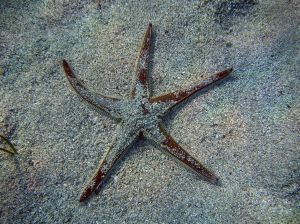Sea Star Facts

Sea star facts # 1
Sea stars are sometimes called star fish, but this is an incorrect name since they are not fishes. The Sea stars do not even belong to the same group of animals as the fishes. Both sea stars and fish are members of the kingdom Animalia, but while all fish are vertebrates belonging to the Phylum Chordata and Subphylum Vertebrata, the Sea stars are found in the Phylum Echinodermata and Class Asteroidea. The Brittle stars are sometimes also referred to as Sea stars, and they belong to the Class Ophiuroidea in the Phylum Echinodermata. The Phylum Echinodermata is a phylum made up by marine animals, while the Phylum Chordata and Subphylum Vertebrata contain not only marine animals, but land living animals and freshwater dwellers as well. A handful of sea star species from the class Ophiuroidea can actually survive in brackish waters, but this adaptation is not common in the phylum Echinodermata.
Sea star fact # 2
We might think of the sea stars and brittle stars as exotic tropical species, but they can actually be found in cooler regions too and are present in all the world’s oceans. You can for instance find brittle stars in the waters of Ross Island and McMurdo Sound, Antarctica. Examples of such cold water species are Astrotoma agassizii, Ophiacantha antarctica, Ophiosparte gigas and Ophionotus victoriae.
Sea star facts # 3
Many sea stars from the class Ophiuroidea (brittle stars) are renowned for being highly adapted to a life at great depths. If you go further down than 500 meters, you can find sea floors overflowing with this type of sea stars. Some Ophiuroidea sea star species have been found below 6000 meters.
Sea star fact # 4
The sea star has its anus located on top of its body.
Seastar fact # 5
The number of “arms” on a sea star can vary from species to species, and even two individuals from the same species can have different numbers of “arms”. A majority of the sea stars will however have five “arms” that are located very evenly around a disc shaped body – typically 72° apart. This type of arrangement is known as pentaradial symmetry.
Sea star facts # 6
The sea star uses a hydraulic water vascular system to feed, transport waste and move around. On the ventral face of the arm of a sea star, you will find small projections. These projections are known as “tube feet”. When the sea star contracts certain muscles, it will force water into a tube feet and make it protrude from the body. The sea star can control its numerous tube feet using different muscles, thus making it possible to move around by alternately contracting or relaxing various tube feet.
Seastar fact # 7
Some sea star species have been successfully kept in captivity by saltwater aquarists. The Caribbean brittle star named Ophiothrix sp. is one example of a sea star that can be very helpful in a reef setup since it will scavenge for food and thereby keep the sensitive corals clean. You can never use medications that contain copper in an aquarium where you keep an Ophiothrix sp. since this will kill or severely harm the sea star.
Sea star Articles
Black Dogface Puffer - Information about Black Dogface Puffer
Bowfin fish - An introduction to living fossils know as Bowfin fish
Boxfish- Information about Boxfish
Crocodile needlefish - An introduction to Crocodile needlefish
Dogface puffer - Information about Dogface puffer
Hogfish - Information about Hogfish
Lionfish - An introduction to lionfish.
Mandarin Goby - An Introduction to the Mandarin goby
Marine Betta - Information about Marine Betta (Calloplesiops altivelis)
Moray eels- An article about how to keep moray eels in aquariums.
Nudibranch - An introduction to Nudibranchs
Octopus aquarium - How to keep and perhaps even breed Octupus in an aquarium.
Pipefish - An introduction to pipefish
Saltwater aquarium fish - An introduction to marine aquarium. fish for beginners.
Sea horses in Aquarium - An article about how to keep sea horses in aquariums.
Sea Stars - An introduction to Sea Stars.
Clownfish Articles:
Black Clownfish - Information about Black clown fish
Breeding Clownfish - A very brief describtion on how to breed clownfish
Percula Clownfish - An article about how to keep and breed Percula breeding.
Tomato Clownfish - An in deepth article about tomato clownfish
